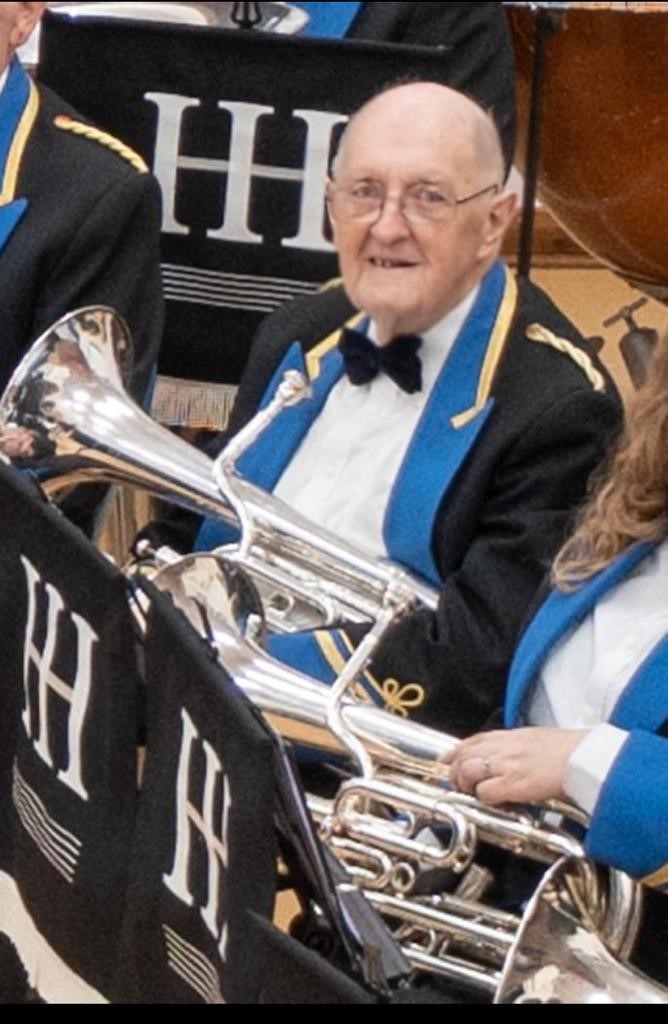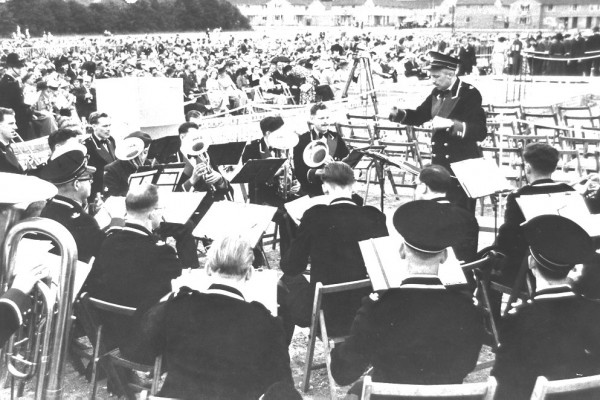
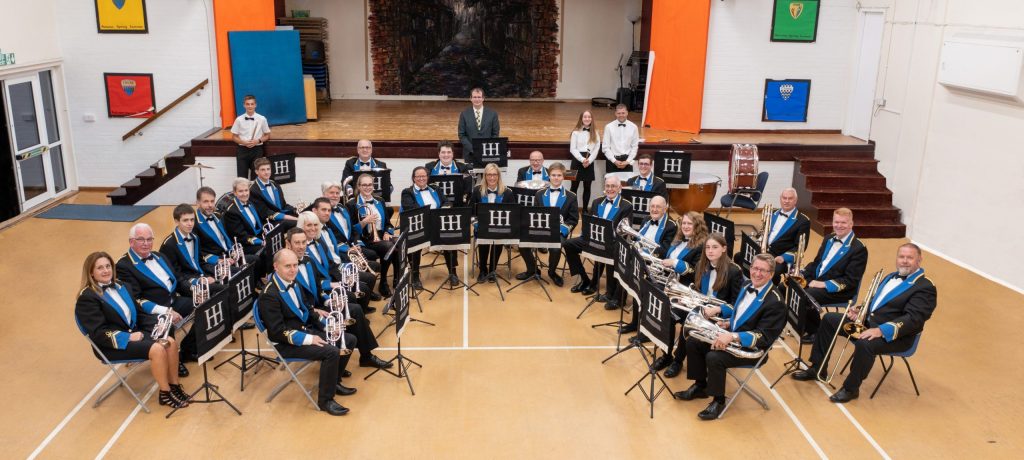
THE MUSICAL STATIONERS : THEIR PLAYING BROUGHT THE ROYAL ALBERT HALL AUDIENCE TO ITS FEET
By Peter Davis and Michael Stanyon
(In the Header Image, Peter Davis can be seen on the front row, right hand side, fourth person along)
First published in: The British Association of Paper Historians, The Quarterly No. 105, January 2018.
A large company like John Dickinson & Co. did a great deal to encourage the leisure activities of their employees. This is a brief account of how employee’s musical talents were used to benefit the Company name.
The Early days
During the late Victorian period making music was a popular way of relaxing and escape; especially from difficult occupations. Collieries and Steel works often had their own bands but in the Hertfordshire area, where similar places of large scale employment were scarce, bands were mainly linked to local churches. In 1894 several enthusiasts approached the management of the John Dickinson Apsley stationery mill about the creation of a company band. This approach, was fully ratified in 1900 when the Band members were allowed six half-days for band matters. On the first anniversary of their formation the members and their wives were invited to tea by the firm’s general manager, R H Ling who praised them for their rapid progress; the occasion concluded with a concert and solo performances.
Competitions provided a spur to improvement as well as bringing cash prizes. During 1888 their first attempt at competition yielded three prizes totalling £8-10s. During these early days the band frequently played for summer concerts in the gardens of local houses. In due course an invitation came from the London County Council to play in London Parks from 1913; a tradition which would continue with breaks until 2003. Dances for Dickinson employees began to be held in the work’s canteen from 1910 for which the band’s players were in demand. Fees were charged for these events and although the bandsmen had to play an annual subscription their annual payments were usually covered by this income. Their first conductor, Mr Baugham was paid £12 annually until he retired in 1919. Notable fund-raising events supported by the band included troop comforts during the Boer War, celebrating the relief of Mafeking, also the Titanic relief fund.
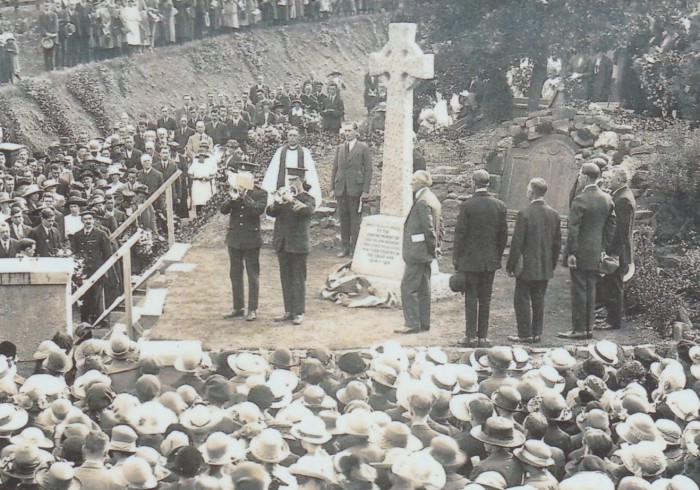
The Band’s buglers at the dedication of the company war memorial in June 1922
Growth
The rapid growth of the company meant that a great many men had to fight during the First World War with 116 Apsley employees losing their lives. Inevitably this had an effect on the band’s members. At the dedication ceremony of the company’s war memorial, in July 1922, it was natural that buglers from the band were called on to sound the Last Post and Reveille. During the 1930’s a general resurgence in brass band playing brought competition playing to the fore. These were arranged around four stages of ability graded from four up to one which was Championship standard. The band entered group four in 1932, by the following year they had won six trophies and been promoted to group three, the next year five trophies leading to advancement to the Championship group. Recognition of their abilities was rewarded by an invitation to play on a BBC radio broadcast in March 1935. Then, from 1937 until the outbreak of the Second World War they broadcast almost monthly. One of the tunes frequently played was The Basildon March composed by their Conductor, JC Dyson. The title of this recalled the company’s then famous Basildon Bond writing stationery range.
Wartime forced the cessation of activities until 1946 when the band was reformed; this time Peter Davis, a young fourteen-year-old engineering apprentice, was amongst the new recruits. By 1948 the band had returned to competitions achieving National Competition standard again in 1957. They had been fortunate in gaining the services of Philip Catalinet, a professor at Trinity College of Music, as Conductor who composed the march, The Lion Rampant, reflecting the company’s famous Lion Brand range of stationery. Geoffrey Brand then took them to new heights as Music Director and Conductor. He had been professionally trained and was music a producer for the BBC. After several years with the Dickinson band Brand left to become the professional conductor for the well-known Black Dyke Mills Band.
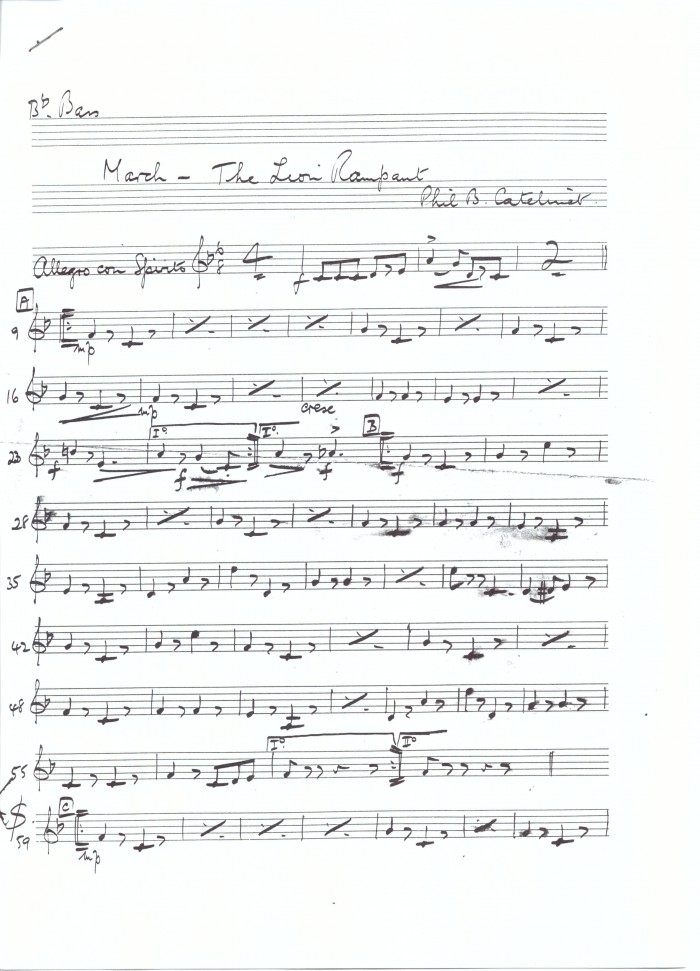
During the 1960’s the fortunes of several of the local bands were in jeopardy with players being absorbed into the Dickinson Band. Unfortunately, in 1965, this coincided with the John Dickinson company sponsorship coming to an end at the end when Dickinson’s merged with the Bristol-based Robinson Group (DRG). Despite this severance the company allowed the band members to retain the instruments and uniforms.
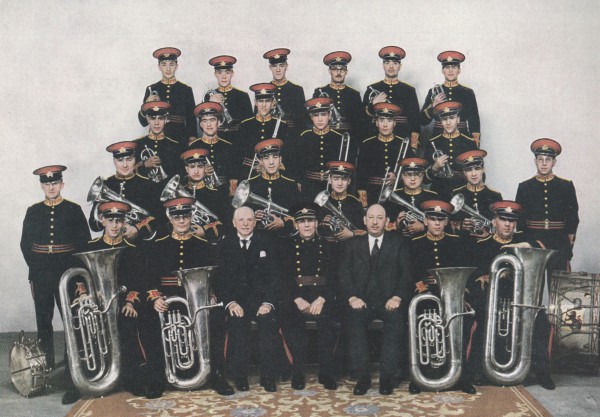
Following a radio broadcast in 1938 the smart uniforms do credit to the John Dickinson company
A public face
The pre-war radio broadcasts were repeated during the 1960’s and 70’s with regular appearances on Friday Night is Music Night and the Charlie Chester Show. Additionally, there were recording sessions, originally on twelve-inch vinyl records, and later on CD and DVD discs. There were many local concerts supporting local charities, also appearances in local parades and parks. A tragic event occurred in August 2004 whilst playing in a Chesham Park when an audience member was fatally stabbed. Band members rendered assistance and calmed the audience but were affected by shock after the event.
In contrast to this band members have often boasted about how they brought the audience of The Royal Albert Hall to their feet; with their rendition of the National Anthem!
A difficult period
The band might have ceased to exist after Dickinson’s withdrew their support in 1965, however, the will to survive, without either sponsorship or practice facilities, produced an unexpected solution. An approach to the Mayor of Hemel Hempstead at a period of Hemel Hempstead’s growth as a New Town meant that many agencies were cooperating rather than adopting the insular attitude prevalent today. The solution was the creation of an evening class in the local adult education college. During this period the name was changed to The Hemel Hempstead Band. The lack of sponsorship and the high cost of uniforms and instruments created a financial crisis. Funds were raised by jumble sales and carol singing to supplement performance fees. Then in 1982 the band’s name was changed to the Hemel Hempstead Atlas Copco Band after obtaining a new sponsorship with the local branch of a Swedish company making air compressors. They became augmented by the players from two other struggling local bands. Several concerts abroad were memorable highlights of this period. Sadly this sponsorship was concluded after 19 years in 1999 after which the name reverted to The Hemel Hempstead Band.
Support from the Heritage Lottery Fund was obtained in 1988 for buying new instruments and again in 2006 for recording their history by holding an exhibition, publishing their story and the creation of a web site.[i]
Home again. Full circle!
Losing the Atlas Copco sponsorship meant that once again the band was without without storage for its instruments and the huge library of music and practice facilities. It was at about the same time that the John Dickinson Stationery company was vacating its Apsley site, some of it in favour of The Apsley Paper Trail (APT). Although APT was unable to offer financial sponsorship they did provide valuable storage and practice facilities. Through this offer some of the earlier John Dickinson Band members could return to their original home; including Peter Davis.
A Mystery
A previously unknown and undated photograph was recently found which caused the enquiry that this article has sprung from. On the rear it states, ‘The John Dickinson Beano Band’ and would appear to be one which performed for local entertainment. Enquiries about this have failed to find an answer. It must remain a mystery for the time being.
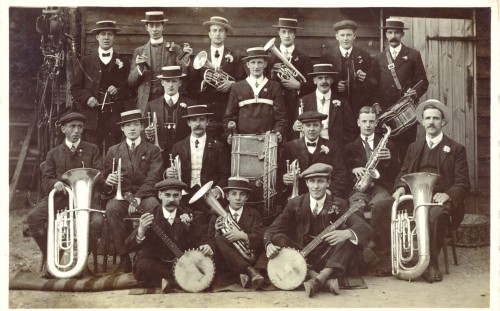
Dickinson’s Beano Band: An undated photograph featuring instrumentalists who may have been off-shoots of the main company band to play in local entertainments
Peter Davis
When Peter joined the John Dickinson band as an engineering apprentice in 1946 he would not have imagined that over seventy years later he would still be playing. After his National Service Peter returned to Apsley to work in the Pocket Envelope Department servicing the machines. It was here that he met his wife Eve who he married in 1956; he continued working here until his retirement in 1996.
The places and experiences which his band membership has led to are many and varied. One of the memorable events was during his national service in the RAF. He was permitted a special leave in July 1952 to play with the band for a visit by HM The Queen to Hemel Hempstead for the laying of a foundation stone for a new church. Peter’s RAF uniform can be seen in photographs of the event. Fifty years later he played again when the occasion of the Queen’s visit was recalled with exhibitions, and community sports and displays.
His work for the band was rewarded in 2006 by an invitation to a Buckingham Palace garden party with his wife Eve, coincidentally, the event was within a few weeks of their golden wedding. He was made Band President in 2014.
